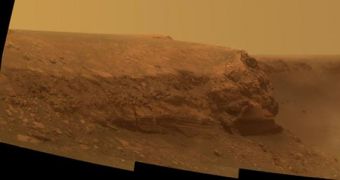The four-year mission in the harsh Martian environment is leaving yet another imprint on one of NASA's twin rovers. While Spirit is currently hibernating in the northern region of the planet, Opportunity is still on route to exploring Victoria Crater's Cape Verde. The voyage to the cliff was recently stopped by a faulty motor which is powering the rover's robotic arm. The problems with the motor had actually began more than two and a half years ago when it started experiencing sporadic functioning. The fix, back then, was relatively simple and required only a slight power boost, while precautionary measures were taken in order to ensure than in case the arm got stuck, it would not remain folded inside the rover. On April 14, while unfolding the arm, the motor stalled much earlier that in any of the previous cases.
"It could be fairly serious - if we can't move that shoulder joint it could restrict the possible motion of the arm," said project scientist Bruce Banerdt of NASA's Jet Propulsion Laboratory. The Instrument Deployment Device, as the arm is called, carries a series of instruments amongst which chemical and mineralogical investigation devices.
"If we did lose the ability to use the instrument on the IDD, that would be a pretty big blow to the missions," said Banerdt. "Even under the worst-case scenario for this motor, Opportunity still has the capability to do some contact science with the arm," reckons John Callas, project manager for the mission at the Jet Propulsion Laboratory.
On route to Cape Verde
When the malfunction appeared, Opportunity was driving through the Victoria Crater on a slope tilted at about 20 degrees. The respective area is filled with surface irregularities and pockets of dust stopped the rover from making good progress, often sending it back on another route. Further diagnostics would determine whether the stretched position of the arm could influence in any way the correct functioning of the other systems present on the rover or it is worth trying to move the arm in the usual way when it stall.
"The arm was not designed to take that kind of stress, if it's kind of hanging out in the breeze or the rover is going over a bump," explained Banerdt.
The rover project scientists were hopping to use the arm during the study of the Cape Verde area of Victoria Crater and other regions outside it.
Strange rocks
Opportunity has just finished studying some rock layers inside the crater, including a specially bright formation called "bathtub ring", identified as a sulphate sandstone which may simply have a smoother texture than the other rocks, thus enabling it to reflect light somehow differently. Spectrometer analysis is expected to reveal whether the rocks contain any chemical differences which may reveal the geological history of the respective area.
"There's all kind of pieces to this puzzle, and there's a lot of them that haven't clicked into place yet," says Banerdt.
Data relayed by the rover showed that the area was an active dune field several millions or even billions years ago, with winds blowing on a north-south direction, pattern that hasn't changed until now.
Spirit
In the north hemisphere, Spirit stands sheltered on the edge of the Home Plate plateau, where it will remain for the next six months or so until the Sun occupies a higher position in the sky. Although stranded in the same location, saving power to remain operational, Spirit is still conducting scientific investigations with the instruments on board.
"Right now the solar panels are about 35 percent of their normal efficiency because of dust coverage, which is pretty bad. It weill be well lower than what Spirit has ever seen but analogous to what Opportunity was dealing with during the dust storm. We're keeping our fingers crossed," said Banerdt.

 14 DAY TRIAL //
14 DAY TRIAL //